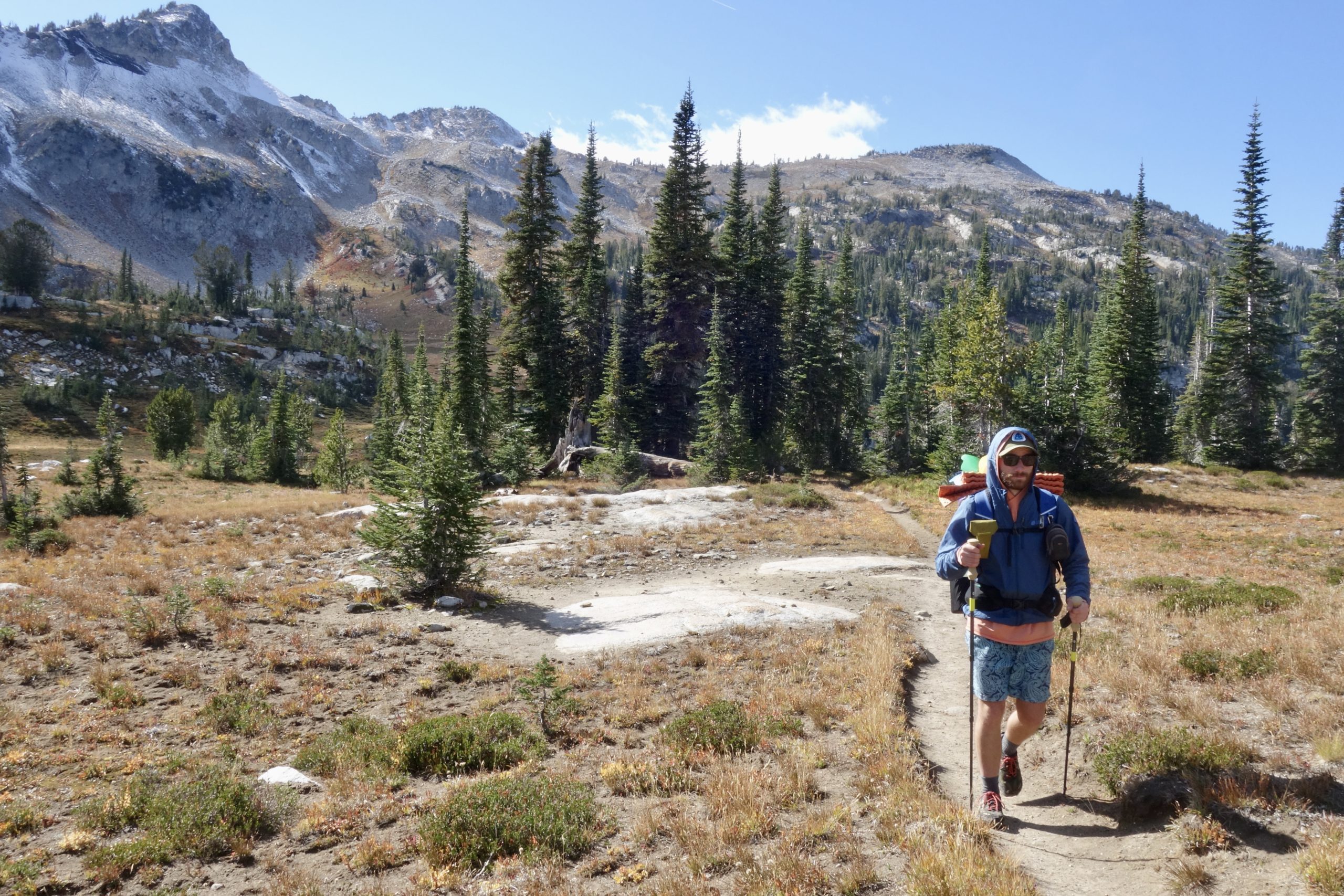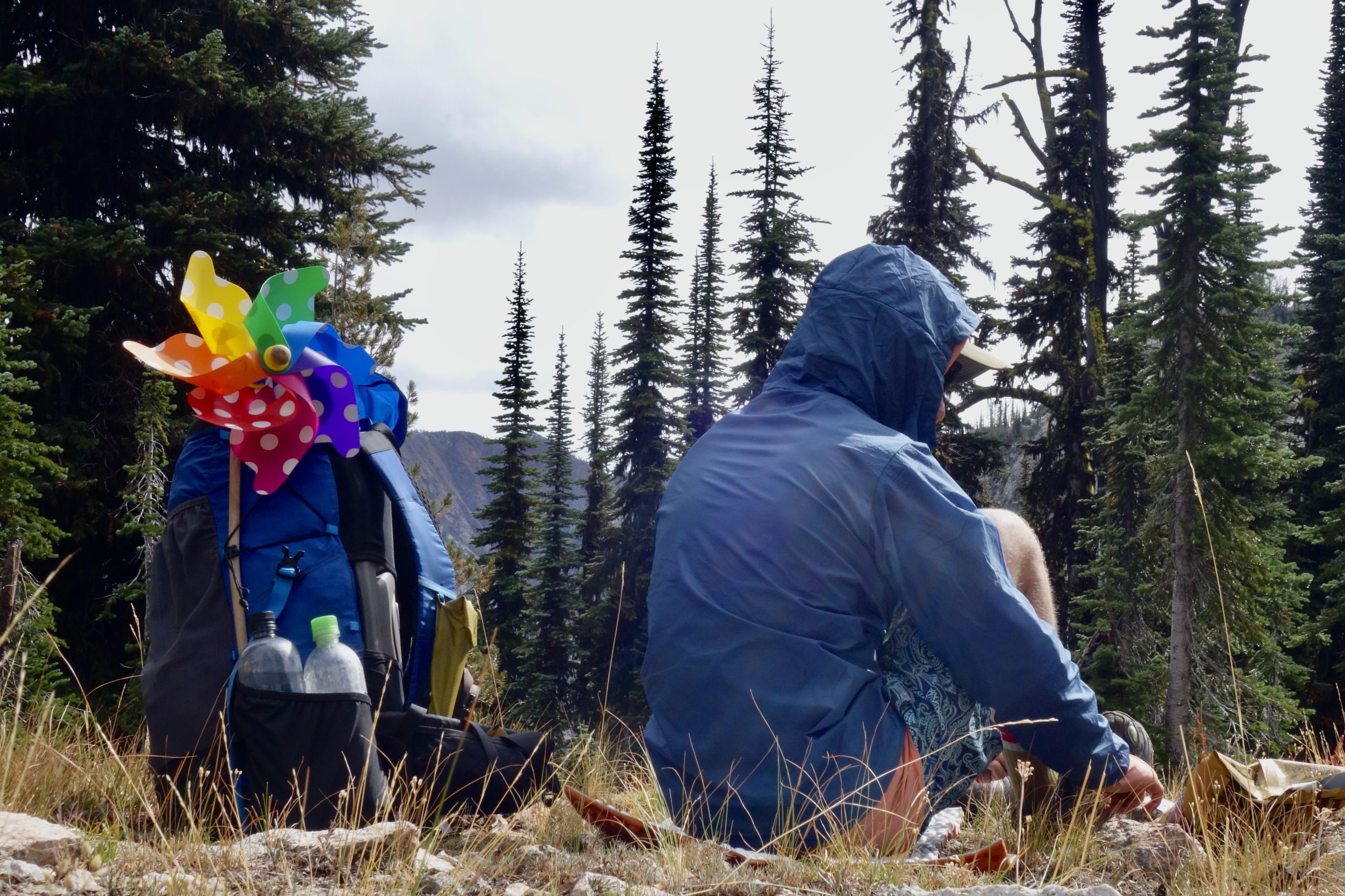Sierra Designs Tepona Wind Jacket Review
Wind jackets first piqued my interest while I was researching gear for my PCT thru-hike in early 2015. I figured that since I was carrying an umbrella anyway, maybe I didn’t need a waterproof rain jacket as well. The feather weight enticed me, but I worried that the DWR finish alone would leave me SOL if the rain started blowing sideways. Ultimately, I had the good sense to go with a rain jacket, which proved to be the right choice when, yes, the rain blew sideways, rendering my umbrella more dangerous than useful.
While I am a firm believer that wind jackets are no substitute for the very important rain jacket, I’ve also come to appreciate the utility of a breathable windbreaker. The vast majority of the time I wore my rain jacket on the PCT, and then the CDT, it was to block the wind, not the rain. I needed just the slightest boost in warmth when the temperature dipped into the 40’s or below. The hard shell did that and was great at cutting the wind chill, but its limited breathability left me swamped in sweat if I got too enthusiastic. Once more, my mind pivoted toward the wind jacket.
But enough about me…
The Tepona Wind Jacket is a new offering from Sierra Designs that aims to bridge that gap between T-shirt and rain jacket. The company markets it as the “first line of defense against nature’s windy offense,” and for less than four ounces. For that minor weight penalty, I was thrilled to have the opportunity to finally see for myself if the previously shunned wind jacket would earn its place on my next thru-hike gear list. I had no doubt that it would become one of my most used layers, but would the boost in breathability over a rain jacket justify the extra ounces? Many miles ahead to find out.
Sierra Designs Tepona Wind Jacket At-a-Glance
MSRP: $89.95
Weight: 3.8 ounces, measured at home
Type: Lightweight wind protection
Material: 15 denier ripstop nylon with DWR finish
Country of origin: Imported
Intended Use
Sierra Designs designed the Tepona Wind Jacket to be so lightweight and packable that it’s hard to find an excuse not to bring it along, whether for a few hours or many days. Like other wind garments, as the name implies, it will cut the wind on a breezy summit or during a blustery bike ride. A DWR finish repels light moisture, but it is important not to harbor unrealistic expectations when it comes to precipitation. The Tepona is not a rain jacket, and that’s a good thing. It’s lighter and more breathable than a hard shell, which makes it a great choice for dry adventures where a slight boost in warmth is all you’ll need to stay comfortable.
Circumstances of Review

Too hot for a mid-layer. Too cold for just a shirt. A wind jacket is a great layer for shoulder season hiking.
I put the Tepona Wind Jacket to the test in a wide variety of conditions and pursuits this autumn and winter. The changing seasons give me the perfect environment in which to test such a strangely versatile layer. Undoubtedly, this jacket has seen more use than any other piece of clothing that I own over the past three months.
I first asked my Tepona to shield me from drizzle, snow, and melancholy vibes on a three-nighter in the rugged Wallowa Mountains of eastern Oregon. I also pushed it well beyond its purview on a damp bike-packing overnighter in the Columbia River Gorge. Additionally, my jacket has seen near-daily use around town in all weather conditions. I’ve included it in everything from walking the dog to bicycle commuting to work. It’s seen a lot, which is a testament to the versatility of a garment designed for a specific purpose that also does a decent job at a lot of other things too.
Sierra Designs Tepona Wind Jacket Features
15D ripstop nylon: The fabric of this jacket is extremely thin and lightweight. When I got my hands on the Tepona, it seemed crazy that it would stop even the slightest breeze, but it does the job. The material has a matte texture resulting from the ripstop construction, which is utilized to prevent small tears from becoming large ventilation “features.” A PFC-free DWR coating helps shed minor drips and dribbles.
Adjustable hood: The well-cut hood cinches down with a single drawcord on the back of the head. It is easy to adjust, makes you look like a pirate, and keeps everything in place when it’s tightened, even in very windy situations.
Adjustable waist: Like the hood, the waist hem tightens to block out drafts with an easily adjusted shock cord.
Elastic cuffs: These basic cuffs are nothing to write home about, but they are simple, lightweight, unobtrusive, and comfortable.
Full-length zipper: This feature is great for ventilation during sweatier activities and makes the jacket easy to throw on or pull off over other layers.
Chest pocket: The single pocket holds the essentials, and acts as a stuff sack when you want to make the Tepona disappear. Bigger smartphones may have trouble slipping through the small, zippered opening, but this pocket holds a surprising amount of widgets and/or doodads.
But why a wind jacket?
The name “wind jacket” says it all. It is a specific tool for a specific job, and the Tepona is great at blocking wind. Wind chill factor is often ignored (I am certainly guilty of fixating on temperature exclusively), but it is super important to consider wind speed when heading outside. A warm day quickly turns chilly, and a cold day turns dangerous if the wind is whipping. A lightweight wind jacket complements other layers by allowing them to do their job instead of having their hard work erased by wind.
Other well-known layers are capable of the same job (i.e. rain jacket for wind, extra mid-layer for warmth), but the humble wind jacket is perfect for some conditions in a way that those other items will never match. A rain jacket will block wind, yet no matter how much marketing claims “our most breathable waterproof fabric yet”, it will never be a great choice for high-output activities unless you don’t mind doing them in a puddle of your own sweat. An extra base- or mid-layer, like a fleece, might boost warmth, but won’t block the wind. Or, if a mid-layer does have wind-stopping properties, it will be too hot on warmer days. A wind jacket is also virtually guaranteed to weigh less and pack smaller than either a rain jacket or fleece.
Of course, it’s not all perfect. Precipitation quickly outmatches the wind jacket, which wets out in light rain. Also, the ultra-thin fabric warmth benefits are marginal. However, a wind jacket excels in the right conditions. And for all their limitations, I reach for my wind jacket far more often than my favorite rain jacket or fleece.
Comfort
The Tepona Wind Jacket is a basic garment that meets its requirements without getting in the way. The lightweight fabric really is just that, and this jacket is as unobtrusive zipped over my shirt as it is stashed in my pack. The nylon has zero stretch and a rough matte texture, but the generous cut allows me full range of motion even when I’m wearing a poofy layer underneath. I would say that it fits true to size, and is not a slim fit.
The hood has good coverage and a functional adjustment cord that keeps it on during chilling face blasts. I’ve never used the adjustable waist feature, but it is reassuring to know that it’s there to block out belly gusts.
Breathability
With super thin fabric and a long zipper, the Tepona falls somewhere between “more breathable than a rain jacket” and “less breathable than nothing.” When backpacking, I didn’t notice that nasty feeling of clamminess even when I was churning up some truly testing climbs. The full-length zipper allowed me to dump excess heat during that awkward time between hiking comfortably and deciding it’s time to take off a layer.
However, I have noticed some arm clamminess while cycling hard with a short-sleeve base-layer. This jacket is not perfectly breathable, nothing is, but it is useable as an active layer nonetheless. It is my favorite solution for cutting the cold during vigorous pursuits where I would quickly sweat out a puffy or rain jacket.
DWR Performance
As I mentioned above, this is not a rain jacket. While the fabric is treated with a DWR finish, the Tepona wets out rather quickly in all but the daintiest of drizzles, although it did a pretty good job in snow. When this happens it can get cold fast, as I found on a rainy day of cycling from Cascade Locks to Portland. Without an insulating layer between my skin and the soggy nylon, it clung to my arms like a wet jellyfish and provided zero protection from the wind. Perhaps with an extra base layer, I would have been fine. But as it was, I was just one hot shower removed from hypothermia and would not recommend using a wind jacket as your only protective layer when things get wet.
Durability
I have not babied the 15D fabric in any way, yet it is showing zero signs of wear after three months of heavy use and the resulting wash cycles. The nylon is ripstop, meaning that if I do tear a hole, I expect it to stay local and easily patchable with repair tape.
Pros
Lightweight: My size small Tepona weighs a minuscule 3.8 ounces. I’m pretty sure that’s less than a side of guacamole at Chipotle. Sure, even small ounces are ounces, but I’d much rather have the Tepona in my backpack than those two expired Lära Bars that I’m never going to eat.
Packable: When stuffed into its pocket, the jacket is about the size of a medium sweet potato. It can squeeze a little bit smaller too when cramming into a little cranny.
Has a pocket: The single chest pocket has its quirks (see cons), but it is still a great feature. It holds my phone and wallet at the same time.
Full-length zipper: Despite the low weight, the Tepona still has a full-length zipper, which helps vent excess heat and makes it easy to throw on with zero risk of getting your face trapped in the inside the hood, which is a horrible place to be.
Quick-dry: Even when my back is soaked with backpack-induced sweat, the thin nylon dries faster than I can eat lunch. For better or worse, this makes me feel better about pushing hard and sweating in the Tepona. Even if I take it a little too far, I am confident that it will dry before I notice that it hasn’t.
Breathable: As long as it stays dry, the Tepona is pretty darn breathable. While some waterproof rain shells are extremely lightweight, weighing just an ounce or two more than this jacket, the increased protection comes with decreased breathability. More rainproof-ness, more sweat. This wind jacket reduces sweat and is a better layer for dry-weather activities, hands down.
Cons
Wet performance: At the risk of stating the obvious, that this wind jacket is not a rain jacket, the Tepona is definitely a dry-weather layer (and a good one at that). At times I have expected a little too much out of this jacket when it comes to keeping me dry, and the Portland gloom has made me pay. When it gets wet, the Tepona provides almost zero added warmth or protection, a lesson I seem incapable of learning.
Flappy pocket: The single chest pocket, handy as it is, has room for improvement. My biggest gripe is that it is only connected to the body of the jacket on two sides of the rectangle, which allows it to flap around inside the jacket when jostled. I tend to wear the Tepona half-zipped and I often find the pocket protruding from the unzipped zipper. Unstylish at best. An easy adjustment with my hand quickly fixes the fashion faux pas temporarily, but I wish that Sierra Designs attached the pocket to the jacket body more securely.
Virgin material: Humans have made enough plastic. Using recycled materials to manufacture synthetic clothing is happening now and is the way of the future. I hope that Sierra Designs joins in the fun soon.
Final Thoughts
Over the past three months, the Tepona Wind Jacket has often felt like a luxury item. My rain jacket fulfills many of the same functions (blocking wind, boosting warmth, keeping me dry), and sometimes it works even better than the Tepona (i.e. rain). Yet, I still grab the wind jacket on all but the rainiest days. By being more breathable than a rain shell, it is a more versatile layer as long as the sky isn’t drizzling, dripping, or dumping, and the minimal weight keeps it in my pack more days than not. I might not need a wind jacket, but it’s a luxury that I use more often than the essentials. The Tepona shines in chilly, dry weather where just a shirt doesn’t cut it. I’ll use it in spring, summer, fall, and winter, just as long as the forecast is dry-ish.
Similar Wind Jackets
Patagonia Houdini
MSRP: $99
Weight: 3.7 ounces
Material: 100% recycled ripstop nylon with DWR
Sustainability: Recycled material, Fair Trade Certified sewing, made in Vietnam
Enlightened Equipment Copperfield Wind Shirt
MSRP: $110-130
Weight: 1.8-3.2 ounces
Material: 7, 10, or 20D ripstop nylon with DWR
Sustainability: Made in USA
Cotopaxi x Teva Teca Windbreaker
MSRP: $90
Weight: 5 ounces
Material: Polyester taffeta with DWR
Sustainability: Constructed with remnant fabric (scraps)
Zpacks Ventum Wind Shell
MSRP: $115
Weight: 1.7 ounces
Material: 7D ripstop nylon with DWR
Sustainability: Made in Japan
Disclaimer: This product was donated for purpose of review.
This website contains affiliate links, which means The Trek may receive a percentage of any product or service you purchase using the links in the articles or advertisements. The buyer pays the same price as they would otherwise, and your purchase helps to support The Trek's ongoing goal to serve you quality backpacking advice and information. Thanks for your support!
To learn more, please visit the About This Site page.










Comments 2
Nice review. It is odd that now the Sierra Designs website states this jacket weighs 7.92 oz in size medium.